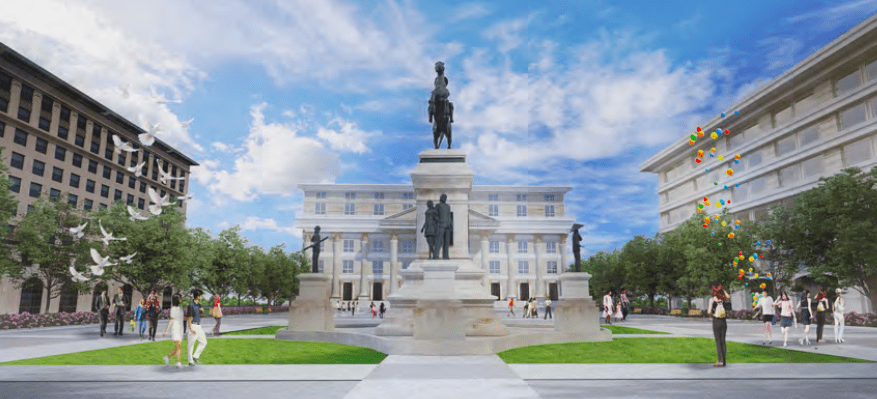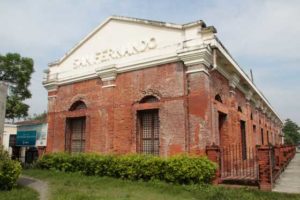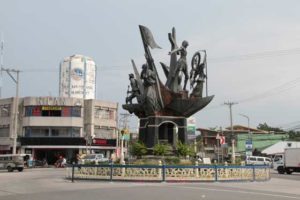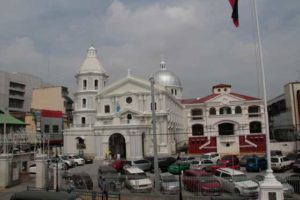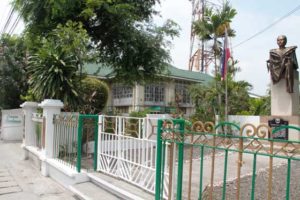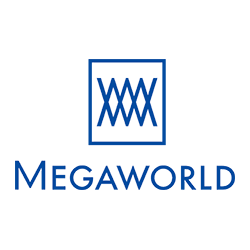Famed for its delicious cuisine, historical destinations, valiant heroes, and giant lanterns, the province of Pampanga – with its proximity to Manila – takes pride as the country’s premier cultural and business hub outside of the megalopolis.
Its capital, San Fernando – founded in 1754 and declared as a city on February 4, 2001 – epitomizes the innate Filipino traits of resilience and adaptability after it literally rose out of the ashes, tragedy and destruction resulting from Mount Pinatubo’s eruption in 1991.
Good governance has also made the capital a consistent winner as a Most Business-Friendly City, most recently at The Manila Times’ Top Model Cities Awards in May, and by the Philippine Chamber of Commerce and Industry (PCCI), which has twice elevated San Fernando to its hall of fame.
Given its conducive business climate, safety is also prioritized in the city as more and more investors coming to live just north of Metro Manila.
A sculptural masterpiece that pays tribute to San Fernando’s colorful history and cultural heritage welcomes visitors to the city proper
Best of all, every visit to San Fernando, whether for work, play or the possibility of planting roots in the area is always worthwhile what with must-visit sites that highlight the rich history and cultural heritage of the heart of Pampanga.
1: The Train Station. Just across the Provincial Capitol is the old San Fernando Train Station. It was inaugurated on February 23, 1892 as part of the Manila-Dagupan Line of the Manila Railroad Company. Historical accounts denote that Jose Rizal alighted this station in 1892 to visit friends in the town and nearby Bacolor to recruit members for La Liga Filipina. A marker further recalls that the station is where the infamous Death March of American and Filipino Prisoners of War during the Japanese occupation culminated from Bataan in 1942. Survivors were said to have been cramped like cattle in box cars and transported to the US Army Base Camp O’Donnel in Capas, Tarlac from here.
Today, the edifice houses the City Tourism Office and serves as Bataan Death March Museum as well.
2: Monumento Fernandino. Welcoming motorists and pedestrians to the city proper is a sculptural masterpiece that pays tribute to San Fernando’s colorful history and cultural heritage. The monument – which seems like a sprouting plant amid a barren landscape when seen from a distance – outlines the Fernandino story: girl with lantern, lady with torch, lady making offering and boatman. It was dedicated by then Mayor Rey Aquino on February 4, 2004 and has the giant City of San Fernando Water District concrete tank as its backdrop.
Heritage Houses abound in the city such as the Henson-Hizon House alternately called Casa Nicolasa
3: Heritage Houses. Still standing and well-preserved are clusters of bahay na bato from the Spanish colonial period. Most prominent among them is the Henson-Hizon House. built by Gobernadorcillo Saturnino Henson y David who also served as San Fernando’s first municipal treasurer. The house was eventually sold to the couple Pablo Panlilio y Dayrit and Dolores Arguelles. It was in this structure that their daughter Nicolasa helped treat wounded Filipino soldiers during the Filipino-American War. The property is also called Casa Nicolasa, and beside it fittingly stands a monument of the heroic woman who is honored yearly at the city’s celebration of Women’s Day on September 10.
Other important heritage houses in this highly interesting part of the city are those of Hizon-Singian, Dayrit-Cuyugan, Don Ramon Lopez’ Tabacalera House whose first floor was used as an office by the cigar manufacturer, Hizon-Ocampo and the Lazatin House which became the official residence of the 14th Army commander of the Japanese Imperial Army and the Consunji House where Jose Rizal drank a cup of coffee.
4: Metropolitan Cathedral. Formerly called the Cathedral of Our Lady of the Assumption, this neo-classical church is the seat of Archdiocese of San Fernando.
Augustinian friars built the first structure of wood and thatch in 1755 under the patronage of Fernando 3rd, King of Castile. The construction of the present style started in 1788 and completed in 1808. The edifice measures 70 meters long, 13 meters wide and 11 meters high. Its round majestic dome is reminiscent of Baroque architecture with tweaks of Renaissance elements.
The Metropolitan Cathedral is the seat of the Archdiocese of San Fernando
According to history, President Emilio Aguinaldo and his cabinet viewed the Philippine Revolutionary Army from the windows of the convento on October 9, 1898. On May 4, 1899, General Antonio Luna burned the church and the convento. It was then rebuilt but destroyed by fire in 1939 and finally restored by Kapampangan architect Fernando Ocampo in 1948. In 2014, the Cathedral underwent major renovation and restoration under the leadership of Msgr. Eugenio Reyes.
Directly across the Cathedral is the municipal hall, which will be turned into a museum when the new building to house the mayor’s office is completed.
5: Pasudeco. The Pampanga Sugar Development Company (Pasudeco) was the first local sugar mill financed by Filipinos in history. The structure was built by Honolulu Iron Works and completed in March 1921. Destroyed by the Mount Pinatubo eruption in 1991, it was rehabilitated and again ravaged by lahar in 1995. Beloved, another rebuilding was undertaken but Pasudeco officially ceased operations in 2015.
Given the site’s significance in San Fernando’s history and cultural heritage, premier development company Megaworld Corporation is implementing an impressive project that will convert the property into a first-class township with all modern components of Live, Work, Play and Learn.
The P30-billion development for the 35.6-hectare property is targeted for completion in five years, and fully functional as an integrated commercial and business district (CBD) and township lifestyle community in 10 years.
Capital Town’s Shophouse District raises the bar in integrated lifestyle township with its three-level shops and residential buildings in what used to be Pasudeco property
Named the Capital Town, the project was born out of the clamor from Megaworld’s business process outsourcing (BPO) clients and locators in Metro Manila who are eager to expand operations outside the megalopolis. This means more jobs and economic growth for the capital.
Marrying the township concept, which Megaworld has successfully developed in other parts of the country, with the Kapampangans’ desire to preserve their unique heritage, Capital Town is anticipated to become the crowning jewel of the real estate development and cultural hub in Central Luzon.
There will be a mall built in the shape of the old sugar mill building, with the machinery and the train used to transport sugar cane tubes from the field as main fixtures. Stalls will have the Kapampangan flair and the Kapampangan dialect will be encouraged as the medium of conversation here.
Envisioned to adorn the mall will be items and artefacts made from lahar. Monuments of Kapampangan heroes and famous personalities will further be erected along roads, alleys, hallways, nooks and pocket parks in the township. Furniture will be supplied by the famous artisans of Betis, while food offerings will of course feature the best of the famed Kapampangan cuisine.
The flagship of the development will be the six-hectare Shophouse District – a lifestyle hub within the community for people who want to build businesses and live there at the same time. It will be highlighted with post-colonial architecture exuding a vibe from the ’40s to the ’50s, throughout the three-level shophouses.
6. Lantern factory. The titles “Christmas Capital of the Philippines” and “Home of Giant Lanterns” have been synonymous to San Fernando since the 1990s. Even with the loss of Paskuhan Village when it was sold by the Tourism Infrastructure and Enterprise Authority (Tieza), pioneer lantern maker Ernesto Quiwa declares the tradition of lantern-making is alive as ever.
Pioneering lantern-maker Ernesto Quiwa at his factory
A fourth-generation artisan, he told The Manila Times that it was his uncle who first used a rotor made out of milk tin cans to make twinkling lanterns in 1957. Quiwa took over the family’s humble business and started selling San Fernando lanterns in 1964.
In 1993 when Mt. Pinatubo erupted, Quiwa trained victims who lost their homes and livelihood in lantern-making sponsored by the Department of Tourism. And since the annual revival of “Ligligan Parul” on December 16, 2016 (which will be celebrated on December 17 this year) the industry is assured continuity. In fact, Quiwa said that 200 families are actively engaged in the craft to cope with the ever-increasing demand for Christmas lanterns from returning OFWs as well as the Australian market.
He further related how his company, Estilo De Quiwa Enterprise, maintains the highest standards – with zero incidence of burning wires or short circuit – whether they make a standard size of one foot to two-feet diameter, or giant lanterns as big as 20 feet and adorned with 7,200 bulbs.
7. Calesa factory and repair shop. Where there used to be 1,000 calesas plying the roads of San Fernando and 2,000 in Angeles City, they only consist a small number of 70 at present around the capital. Third-generation craftsman Ben Lingad has only one worker left, and said he does not regret not teaching his two sons about the craft.
Modernization came with the proliferation of motor vehicles. And with the high cost of buying and maintaining a horse, the industry died a natural death.
The only vestige of the once-flourishing craft are works in progress of a calesa for Fort Santiago and a carriage for the City of Vigan in Ilocos Sur, which visitors will still witness on this site.
8. Arzobizpado de Pampanga. Called Bahay Pari (not the Kapampangan “Bale”) by local residents, the Chancery with its mansion-like façade and architecture is home to old priests and retired bishops of the Catholic Church. It has also become a popular wedding reception venue.
Within the same grounds is the Virgen delos Remedios Repository Chapel and the Garden of Healing and Peace with an imposing statue of Christ inviting, “Come unto me you who are heavy laden and I will give you rest.”

